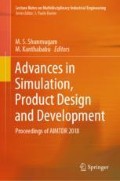Abstract
Productivity is the performance paradigm implying the transformation of man power and material sources into essential goods and utilities. Instant study is concerned with a small-scale production unit near Ambala, Haryana, manufacturing quality tractor parts and fulfilling the monthly requirement of big customers such as Swaraj tractors, Standard, Preet, and Sonalika tractors. The primary goal of the implemented research was to examine the determinants required for reduction of cycle time and betterment of productivity at the manufactory level. The recommended clustering for manufacturing the intended components is designed by developing a universal setup to target the non-productive elements, i.e., setting time. Needful was achieved by stimulating the monthly production and dropping the component manufacturing cost by way of reducing its cycle time by employing clustering principle. p-chart for fraction defectives employed as a statistical tool. Experimentation reveals that validating improved processes and tooling, a total productivity improvement of above 10% was observed.
Access this chapter
Tax calculation will be finalised at checkout
Purchases are for personal use only
References
Adam, E.E.: Alternative quality improvement practices and organization performance. J. Oper. Manag. 12(1), 27–44 (1994). https://doi.org/10.1016/0272-6963(94)90004-3
Lieberman, M.B., Demeester, L.: Inventory reduction and productivity growth: linkages in the Japanese automotive industry. Manage. Sci. 45(4), 466–485 (1999). https://doi.org/10.1287/mnsc.45.4.466
Bouman, B.A.M., Tuong, T.P.: Field water management to save water and increase its productivity in irrigated lowland rice. Agric. Water Manag. 49(1), 11–30 (2001). https://doi.org/10.1016/S0378-3774(00)00128-1
Jin, D., Thunberg, E., Kite-Powell, H., Blake, K.: Total factor productivity change in the New England groundfish fishery: 1964–1993. J. Environ. Econ. Manag. 44(3), 540–556 (2002). https://doi.org/10.1006/jeem.2001.1213
Sheth, J.N., Sisodia, R.S.: Marketing productivity: issues and analysis. J. Bus. Res. 55(5), 349–362 (2002)
Lall, S.V., Shalizi, Z., Deichmann, U.: Agglomeration economies and productivity in Indian industry. J. Dev. Econ. 73(2), 643–673 (2004). https://doi.org/10.1016/j.jdeveco.2003.04.006
Görg, H., Hanley, A.: International outsourcing and productivity: evidence from the Irish electronics industry. North Am. J. Econ. Finance 16(2), 255–269 (2005). https://doi.org/10.1016/j.najef.2004.11.006
Oweis, T., Hachum, A.: Water harvesting and supplemental irrigation for improved water productivity of dry farming systems in West Asia and North Africa. Agric. Water Manag. 80(1–3), 57–73 (2006). https://doi.org/10.1016/j.agwat.2005.07.004
Playán, E., Mateos, L.: Modernization and optimization of irrigation systems to increase water productivity. Agric. Water Manag. 80(1–3), 100–116 (2006). https://doi.org/10.1016/j.agwat.2005.07.007
Fernandes, A.M.: Firm productivity in Bangladesh manufacturing industries. World Dev. 36(10), 1725–1744 (2008). https://doi.org/10.1016/j.worlddev.2008.01.001
Restuccia, D., Rogerson, R.: Policy distortions and aggregate productivity with heterogeneous establishments. Rev. Econ. Dyn. 11(4), 707–720 (2008). https://doi.org/10.1016/j.red.2008.05.002
Restuccia, D., Yang, D.T., Zhu, X.: Agriculture and aggregate productivity: a quantitative cross-country analysis. J. Monetary Econ. 55(2), 234–250 (2008). https://doi.org/10.1016/j.jmoneco.2007.11.006
Worthington, A.C., Lee, B.L.: Efficiency, technology and productivity change in Australian universities, 1998–2003. Econ. Educ. Rev. 27(3), 285–298 (2008). https://doi.org/10.1016/j.econedurev.2006.09.012
Nataraj, S.: The impact of trade liberalization on productivity: evidence from India’s formal and informal manufacturing sectors. J. Int. Econ. 85(2), 292–301 (2011). https://doi.org/10.1016/j.jinteco.2011.07.003
Shanmugaraja, M., Nataraj, M., Gunasekaran, N.: Defect control analysis for improving quality and productivity: an innovative Six Sigma case study. Int. J. Qual. Innov. 1(3), 259–282 (2011)
Sivakumar, A., Saravanan, K.: A simulation-based analysis for improvement of productivity in sick chemical dyeing factory: a research article. Int. J. Electron. Transp. 1(1), 96–110 (2011). https://doi.org/10.1504/IJET.2011.043112
Saleeshya, P.G., Bhadran, A.: Productivity improvement through lean initiative in a surgical equipment manufacturing company: a case study. Int. J. Bus. Syst. Res. 9(4), 297–314 (2015). https://doi.org/10.1504/IJBSR.2015.072580
Dangayach, G.S., Guglani, L.: Application of Moldflow and Taguchi technique in improving the productivity of injection moulded energy meter base. Int. J. Process Manag. Benchmark. 5(3), 375–385 (2015). https://doi.org/10.1504/IJPMB.2015.070820
Sarkar, A., Mukhopadhyay, A.R., Ghosh, S.K.: Productivity improvement by reduction of idle time through application of queuing theory. Opsearch 52(2), 195–211 (2015). https://doi.org/10.1007/s12597-014-0177-2
Singh, S., Singhal, S.: Productivity betterment: implementation of clustering with improved tooling in manufacturing. Int. J. Prod. Manag. Assess. Technol. (IJPMAT) 6(2), 1–18 (2018). https://doi.org/10.4018/IJPMAT.2018070101
Goldar, B., Krishna, K.L., Aggarwal, S.C., Das, D.K., Erumban, A.A., Das, P.C.: Productivity growth in India since the 1980s: the KLEMS approach. Indian Econ. Rev. 52(1–2), 37–71 (2017). https://doi.org/10.1007/s41775-017-0002-y
Singh, S., Singhal, S.: Productivity perfection and analysis in manufacturing top cover: implementing clustering approach with combination tooling. J. Eng. Technol. 6, 339–353 (2018)
Benkovskis, K.: Misallocation, productivity and fragmentation of production: the case of Latvia. J. Prod. Anal. 49(2–3), 187–206 (2018). https://doi.org/10.1007/s11123-018-0530-1
Triebs, T.P., Kumbhakar, S.C.: Management in production: from unobserved to observed. J. Prod. Anal. 49(2–3), 111–121 (2018). https://doi.org/10.1007/s11123-018-0526-x
Sangani, R., Kottur, V.K.N.: Enhancement in productivity by integration of 5S methodology and time and motion study. In: Proceedings of International Conference on Intelligent Manufacturing and Automation (pp. 541–550). Springer, Singapore. https://doi.org/10.1007/978-981-13-2490-1_50 (2019)
Acknowledgements
The author is grateful to Ambala College of Engineering and Applied Research (ACE) for providing necessary facilities. I would also like to express a broad sense of gratitude to my Supervisor Dr. Sandeep Singhal, Associate Professor, Department of Mechanical Engineering, NIT Kurukshetra for imparting his able guidance without which this work would have been impossible.
Author information
Authors and Affiliations
Corresponding author
Editor information
Editors and Affiliations
Rights and permissions
Copyright information
© 2020 Springer Nature Singapore Pte Ltd.
About this paper
Cite this paper
Singh, S., Singhal, S. (2020). Productivity Improvement by Reduction of Cycle Time Through Implementing Clustering: A Case Study. In: Shunmugam, M., Kanthababu, M. (eds) Advances in Simulation, Product Design and Development. Lecture Notes on Multidisciplinary Industrial Engineering. Springer, Singapore. https://doi.org/10.1007/978-981-32-9487-5_61
Download citation
DOI: https://doi.org/10.1007/978-981-32-9487-5_61
Published:
Publisher Name: Springer, Singapore
Print ISBN: 978-981-32-9486-8
Online ISBN: 978-981-32-9487-5
eBook Packages: EngineeringEngineering (R0)

